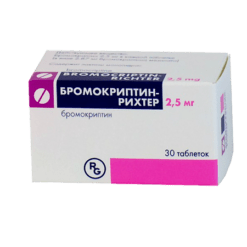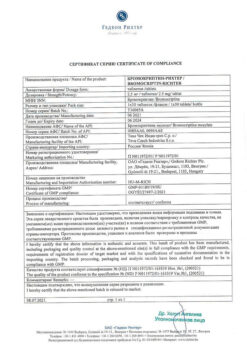No products in the cart.
Bromocriptine, tablets 2.5mg 30 pcs
€9.00 €8.22
Out of stock
(E-mail when Stock is available)
Description
Bromocriptine is a stimulator of central and peripheral D 2 -dopamine receptors (ergot alkaloid derivative). By inhibiting prolactin secretion, it suppresses physiological lactation, promotes normalization of menstrual function, suppresses increased secretion of growth hormone and reduces the size and number of cysts in the breast (due to elimination of imbalance between progesterone and estrogens).
In high doses it stimulates dopamine receptors of the striatum, black nucleus of the brain, hypothalamus and mesolimbic system. It has antiparkinsonian effect, inhibits secretion of somatotropic (STH) and adrenocorticotropic (ACTH) hormones.
After a single dose decrease in plasma prolactin level comes in 2 hours, maximum effect – in 8 hours, antiparkinsonian effect – in 30-90 minutes, maximum – in 2 hours, decrease in STH level – in 1-2 hours, the maximum effect is achieved after 4-8 weeks of therapy.
Pharmacokinetics
After oral administration absorption of bromocriptine from the gastrointestinal tract is 28%. Subjected to the effect of “first passage” through the liver. Bioavailability is 6%. Time to reach maximum concentration in blood plasma is 1-3 hours. T1/2 biphasic: 4-4.5 hours in α-phase, 1 hour in terminal phase.
Binding with plasma albumin is 90-96%.
Extracted mainly with feces – 85.6% and to a small extent with urine – 2.5-5.5%.
Indications
Indications
Menstrual irregularities, female infertility: prolactin-dependent diseases and conditions, accompanied or not accompanied by hyperprolactinemia (amenorrhea, accompanied and not accompanied by galactorrhea; oligomenorrhea; luteal phase deficiency; secondary drug-induced hyperprolactinemia); prolactin-independent female infertility (polycystic ovary syndrome; anovulatory cycles – as an additional therapy to antiestrogens).
Premenstrual syndrome: breast tenderness; swelling associated with the phase of the cycle; flatulence; mood disorders.
Hyperprolactinemia in men: prolactin-dependent hypogonadism (oligospermia, loss of libido, impotence).
Prolactinomas: conservative treatment of prolactin-secreting micro- and macroadenomas of the pituitary gland; in the preoperative period to reduce the size of the tumor and facilitate its removal; postoperative treatment if prolactin levels remain elevated.
Suppression of lactation: prevention or cessation of postpartum lactation for medical reasons – prevention of lactation after abortion; postpartum breast engorgement; incipient postpartum mastitis.
Benign diseases of the mammary glands: mastalgia in isolation or in combination with premenstrual syndrome or benign nodular or cystic changes); benign nodular and/or cystic changes, especially fibrocystic mastopathy.
Parkinson’s disease and parkinsonism syndrome, incl. after encephalitis (as monotherapy or in combination with other antiparkinsonian drugs).
Pharmacological effect
Pharmacological effect
Bromocriptine is a stimulator of central and peripheral D 2 -dopamine receptors (ergot alkaloid derivative). By inhibiting the secretion of prolactin, it suppresses physiological lactation, helps normalize menstrual function, inhibits increased secretion of growth hormone, reduces the size and number of cysts in the mammary gland (by eliminating the imbalance between progesterone and estrogens).
In high doses, it stimulates dopamine receptors in the striatum, the black nucleus of the brain, the hypothalamus and the mesolimbic system. It has an antiparkinsonian effect, suppresses the secretion of somatotropic (GH) and adrenocorticotropic (ACTH) hormones.
After taking a single dose, a decrease in the level of prolactin in the blood plasma occurs after 2 hours, the maximum effect – after 8 hours, the antiparkinsonian effect – after 30-90 minutes, the maximum – after 2 hours, the decrease in the level of growth hormone – after 1-2 hours, the maximum effect is achieved after 4-8 weeks. therapy.
Pharmacokinetics
After oral administration, absorption of bromocriptine from the gastrointestinal tract is 28%. Subject to a first-pass effect through the liver. Bioavailability – 6%. The time to reach maximum concentration in blood plasma is 1-3 hours. T1/2 biphasic: 4-4.5 hours in the α-phase, 1 hour in the terminal phase.
Binding to plasma albumin is 90-96%.
It is excreted mainly in feces – 85.6% and to a small extent in urine – 2.5-5.5%.
Special instructions
Special instructions
To prevent nausea and vomiting at the beginning of treatment, it is advisable to prescribe antiemetic drugs 1 hour before taking the drug.
Periodic monitoring of blood pressure, liver and kidney function is recommended.
When using the drug in high doses for a long period, the risk of developing cardiac fibrosis is increased.
Treatment may cause accelerated resumption of ovarian function after childbirth, and therefore it is necessary to warn women about the possibility of early postpartum conception. In women taking bromocriptine, treatment should be discontinued if pregnancy occurs unless the possible benefit of treatment outweighs the potential risk to the fetus. During therapy, it is advisable to use non-hormonal contraception.
If pregnancy occurs due to pituitary adenoma after discontinuation, systematic monitoring of its condition, including visual field examination, is necessary. Before starting treatment for benign diseases of the mammary glands, it is necessary to exclude the presence of a malignant tumor of the same location.
When treating acromegaly, if there is a history of gastric ulcers, it is better to refuse treatment. If treatment is necessary, draw patients’ attention to the need to notify the doctor if gastrointestinal disorders occur.
It is necessary to carefully observe oral hygiene; if dry mouth persists for more than 2 weeks, you should consult a doctor.
– Impact on the ability to drive vehicles and operate machinery. Patients taking the drug should refrain from engaging in activities that require increased attention and rapid physical and mental reactions.
Active ingredient
Active ingredient
Bromocriptine
Composition
Composition
1 tablet contains:
Active substance:
bromocriptine mesylate 2.87 mg;
Excipients:
lactose monohydrate 55.63 mg,
microcrystalline cellulose 20 mg,
potato starch 15 mg,
carboxy methyl starch sodium 2 mg,
povidone (polyvinylpyrropidone) 3.5 mg,
magnesium stearate 1 mg.
Pregnancy
Pregnancy
Use with caution during pregnancy and lactation.
Contraindications
Contraindications
Hypersensitivity to bromocriptine and other ergot alkaloids.
Preeclampsia.
Arterial hypertension in the postpartum period.
Diseases of the cardiovascular system (including arterial hypertension, hypotension).
Essential, familial tremor.
Psychoses.
Liver failure.
Gettington’s chorea.
Ulcerative lesions of the gastrointestinal tract.
Childhood.
With caution:
Parkinsonism with symptoms of dementia.
Pregnancy.
Lactation period.
Simultaneous administration of antihypertensive therapy.
Side Effects
Side Effects
From the digestive system: nausea, vomiting, dry mouth, constipation, diarrhea, liver dysfunction.
From the central nervous system: dizziness (usually occurs in the first week of treatment), headache, drowsiness, psychomotor agitation, dyskinesia, decreased visual acuity, hallucinations.
From the cardiovascular system: orthostatic hypotension, arrhythmia; in some cases, with long-term use – Raynaud’s syndrome (especially in predisposed patients).
Allergic reactions: skin rash.
Other: nasal congestion, cramps in the calf muscles.
Interaction
Interaction
Reduces the effectiveness of oral contraceptives.
Enhances the effect of levodopa, antihypertensive drugs.
Monoamine oxidase inhibitors, furazolidone, procarbazine, sepegiline, ergot alkaloids, haloperidol, loxapine, methyldopa, metocpopramide, molindone, reserpine, thioxanthines and phenothiazines increase plasma concentrations and the risk of side effects.
Erythromycin, clarithromycin, troleandomycin increase bioavailability and maximum concentration, butyrophenones reduce effectiveness.
Simultaneous intake of ethanol leads to the development of disulfiram-like reactions (chest pain, skin hyperemia, tachycardia, nausea, vomiting, reflex cough, throbbing headache, blurred vision, weakness, convulsions).
When co-administered with ritonavir, a 50% dose reduction is recommended.
Overdose
Overdose
Symptoms: headache, hallucinations, decreased blood pressure.
Treatment: parenteral administration of metoclopramide.
Storage conditions
Storage conditions
In a dry place, protected from light, at a temperature of 2–8 °C
Shelf life
Shelf life
3 years
Manufacturer
Manufacturer
Ozon, Russia
Additional information
| Shelf life | 3 years |
|---|---|
| Conditions of storage | In a dry, light-protected place at 2-8 °C |
| Manufacturer | Ozon, Russia |
| Medication form | pills |
| Brand | Ozon |
Other forms…
Related products
Buy Bromocriptine, tablets 2.5mg 30 pcs with delivery to USA, UK, Europe and over 120 other countries.















